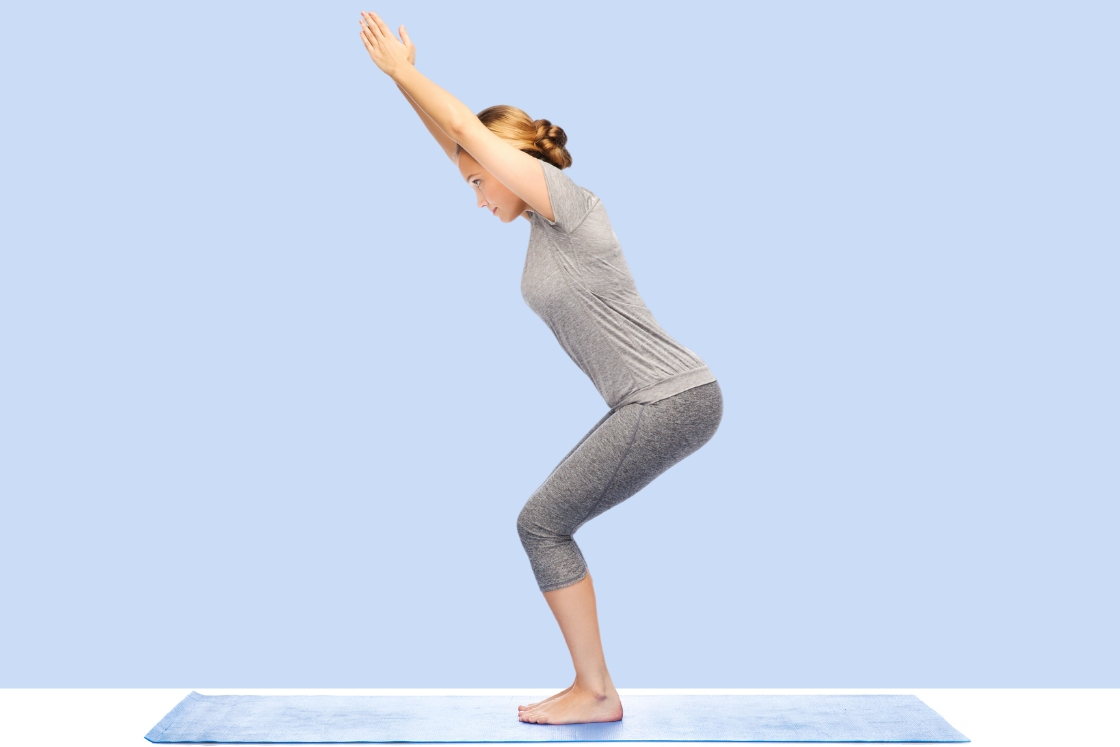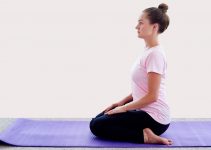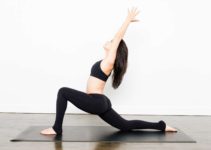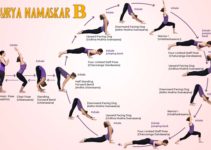
| Sanskrit Pronunciation | Utkatasana – Oot-kah-tah-san-ah (उत्कटासन) |
| Meaning | Utkat – Intense Asana – Pose |
| Pose Type | Standing and Balancing |
| Pose Level | Beginner, perform for 60 seconds |
| Beneficial In | Strengthening legs and lower back |
| Known as | Chair Pose, Fierce Pose, Awkward Pose |
How it seems to sit on an imaginary chair? This is something we can feel in the Utkatasana, a chair-like yoga pose.
Table of Contents
- Chair Pose: Utkatasana
- Meaning & Interpretation
- How to Do Chair Pose: Step by Step Instructions
- Variations
- Tips and modifications
- Benefits of Chair Pose
- Precautions & contraindications
Chair Pose: Utkatasana
Chair pose is a standing squat that let upper and lower body muscles strengthen simultaneously. While holding this pose for a while, you will feel an intense stretch in the shoulder & upper back. On regular practice, your quadriceps, gluteus, calves, ankles get strengthen.
The current version of Chair pose is given by the father of modern yoga, T. Krishnamacharya. Before, It was practiced as a complete lower squatting pose like malasana.
This pose is used in many Ashtanga and Vinyasa yoga sequence as a transition pose from standing to forward bend and forward bend to sitting pose.
As this is a transition zone pose between standing and sitting poses, it’s an amalgamation of balance, stability, and strength.
- In Sun Salutation B sequence, chair pose is the second pose after mountain pose.
- In Light on Yoga, B.K.S Iyengar shows in Chair pose, thighs ideally should be parallel to the floor, and torso slightly bends to open the chest.
- In Bikram Yoga, it’s practiced known as awkward chair pose.
An awkward chair is called when you lower down your bottom to rest on a seat but it isn’t present there so you engage your thighs and quadriceps to be in the pose. In this same way, we go down in chair pose to sit on an invisible chair.
Meaning & Interpretation
English translation of this pose is simple but the Sanskrit one has many meanings and interpretations to understand.
Chair symbolizes a seat or throne which raise one above the normal level of the ground. In this way, the chair also is a way of showing power that makes one distinguishable among other people.
Utkatasana is said to be “Powerful” or “Intense” pose as being in this pose we can feel the invisible seat or throne all we have. Though this seat isn’t a physical one rather when we strengthen ourselves physically, it makes us “above the usual” both mentally and spiritually.
Hence, Chair pose has a great in-depth meaning:
Tapping the leadership quality all we have to sit over a powerful seat from which we can lead all problems of life with ease.
How to Do Chair Pose: Step by Step Instructions
To perform Chair pose, simply come in standing pose in front of your mat and follow the instructions below.
Step 1 – Preparing the Asana
- Firstly, stand tall and straight in Tadasana (Mountain Pose).
- Keep your feet hip-width apart and knees in-line with feet.
- Take a couple of deep breaths here.
Step 2 – Getting Into the Asana
- Inhale and raise your arms over your head. Keep the arms straight and palms facing towards each other.
- Exhale, bend your knees and lower your hips till your thighs become almost parallel to the floor. Keep your knees just above the feet.
- Lean your upper body slightly forwards.
Note – Ideally, your torso should be 90 degrees to your thighs. You might have to raise your thighs a bit to form a 90-degree angle to your torso.
- Draw your shoulder blades downwards, into your upper back.
- Lengthen your spine and stretch the whole back.
- Now, gaze straight and start taking deep breaths for the flow of prana.
- Hold this position for 60 seconds breathing deeply.
Checkpoints
When you are performing the Chair Pose, you must take care of the following points.
- Your arms should be straight, elbows close to your ears.
- Shoulders should be relaxed. Do not bring them close to your ears.
- Your back should be lengthened and torso slightly bent forwards.
- Both knees should be just above the feet. Knees should not be ahead then your toes and toes should be pointing forwards.
- Your thighs should be almost parallel to the floor but slightly lifted.
Step 3 – Releasing the Asana
- When you are done, take a deeper breath.
- Then, with an inhalation, straighten your legs.
- Exhale, lower your arms, come back into Tadasana (Mountain Pose), as in Step 1, and relax.
Note- If you are performing this asana in the Sun Salutation sequence, move directly into Standing Forward Fold (Uttanasana) after this pose ends.
Variations
To take your practice of Utkatasana to the next level or to make the pose more intense, try some of the following variations.
- Ardha Utkatasana (Half Chair Pose) – In this variation, while the knees are bent, place the right foot over the left thigh, just above the left knee. While maintaining the balance bring the palms in Anjali Mudra at your heart. Keep stretching the hips out and throw the shoulders back. Hold and then repeat with the left leg.
- Parivrtta Utkatasana (Revolved Chair Pose) – While the knees are bent, twist your torso at the chest and the shoulders. Move towards the right side and place the left elbow on the outside of the right knee for support. Push the knee with the left elbow, open your chest, join the palms in front of the chest, and gaze upward. Repeat on the left side.
- Utkata Konasana Variation (Goddess Pose Variation) – Widen your feet more than hip-distance apart, and rotate your feet outside. Here you have two options, either join your hand in Namaskara mudra or rest them on your knees for better support.
Tips and Modifications
- Place a folded blanket under your feet for better support and comfort.
- In the beginning, you can straighten the arms at shoulder level, parallel to the floor, instead of raising them over the head. It is much comfortable for beginners.
- If your knees are getting closer unconsciously, you can place a yoga block between your lower thighs. This will help you to get a proper alignment.
- You can ask a friend to check your alignment. You can take help with the perfect alignment.
- If you find raising your hands easy, you can grab the clasp both palms with each other over the head.
- To make this asana more challenging, you can gaze upward, between your both palms.
Benefits of Chair Pose
- The alignment of the body in Chair pose is such a way that it puts a good amount of pressure on the lower body. Hence, it strengthens the lower body especially thighs, hip flexors, hamstrings, calves, and gluteus.
- As Utkatasana is a good chest opener it improves the health of diaphragm and promotes good respiration. In this way, this pose is beneficial for asthma patients.
- It makes the feet strong and maintains the good health of the arches of the feet. Thus, the chair pose is very beneficial in treating the flat feet.
- Chair Pose has a good impact on the muscles of the core. Through the massage of the core muscles and organs, this asana improves the digestion and detoxification of the body.
- This asana stretches the spine and expands the variable columns. It tones the whole spine and improves spinal health.
- Utkarasana improves the body’s strength and stamina. It enhances mental endurance and stability. Also, this asana is said to stimulate the energy channels around the heart & heart chakra.
- Performing this asana for a few minutes gently increases the heart rate. It results in a better flow of the blood to the whole body. Thus, this asana improves the metabolism and circulatory system of the body.
- Chair Pose soothes the nervous system and brings peace to the mind. It removes the restlessness of the mind and helps to improve mental focus.
- This asana helps a lot to remove stiffness of the shoulders, arms, back, and thighs. It improves the overall flexibility of the body.
Precautions and Contraindications
- Perform this asana slowly and gently. Performing it in a hurry can result in the wrong alignment which may cause knee injury.
- It is better to perform Utkatasana on an empty stomach or perform it at least 4 hours after having a meal.
- If you have shoulder pain, do not raise your hands over your head. Instead, join your palms close to your chest, as in Anjali Mudra.
- During mensuration cycles, it is better to perform it under the supervision of an expert.
- If you have any injury on your feet, knees, thighs, spine, or shoulder, do not perform this asana at all.
- If you have heal issues like arthritis in knees, back & knee pain, ligament problems, low blood pressure, or headaches, avoid this asana.
- In the case of pregnancy, do a modified version of the Chair pose.




